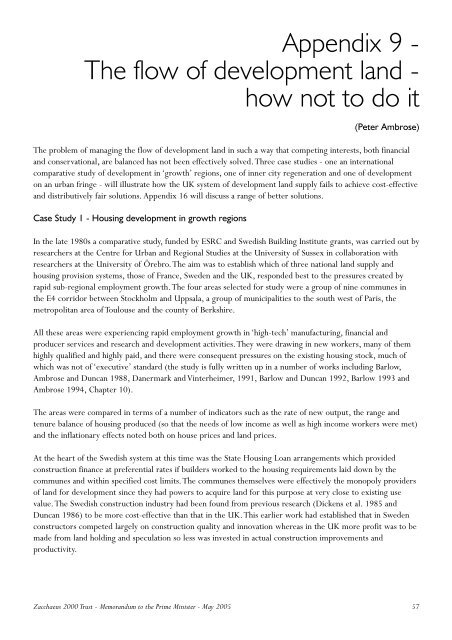Memorandum-to-the-Prime-Minister-on-Unaffordable-Housing
Memorandum-to-the-Prime-Minister-on-Unaffordable-Housing
Memorandum-to-the-Prime-Minister-on-Unaffordable-Housing
You also want an ePaper? Increase the reach of your titles
YUMPU automatically turns print PDFs into web optimized ePapers that Google loves.
Appendix 9 -<br />
The flow of development land -<br />
how not <str<strong>on</strong>g>to</str<strong>on</strong>g> do it<br />
(Peter Ambrose)<br />
The problem of managing <str<strong>on</strong>g>the</str<strong>on</strong>g> flow of development land in such a way that competing interests, both financial<br />
and c<strong>on</strong>servati<strong>on</strong>al, are balanced has not been effectively solved.Three case studies - <strong>on</strong>e an internati<strong>on</strong>al<br />
comparative study of development in ‘growth’ regi<strong>on</strong>s, <strong>on</strong>e of inner city regenerati<strong>on</strong> and <strong>on</strong>e of development<br />
<strong>on</strong> an urban fringe - will illustrate how <str<strong>on</strong>g>the</str<strong>on</strong>g> UK system of development land supply fails <str<strong>on</strong>g>to</str<strong>on</strong>g> achieve cost-effective<br />
and distributively fair soluti<strong>on</strong>s. Appendix 16 will discuss a range of better soluti<strong>on</strong>s.<br />
Case Study 1 - <strong>Housing</strong> development in growth regi<strong>on</strong>s<br />
In <str<strong>on</strong>g>the</str<strong>on</strong>g> late 1980s a comparative study, funded by ESRC and Swedish Building Institute grants, was carried out by<br />
researchers at <str<strong>on</strong>g>the</str<strong>on</strong>g> Centre for Urban and Regi<strong>on</strong>al Studies at <str<strong>on</strong>g>the</str<strong>on</strong>g> University of Sussex in collaborati<strong>on</strong> with<br />
researchers at <str<strong>on</strong>g>the</str<strong>on</strong>g> University of Örebro.The aim was <str<strong>on</strong>g>to</str<strong>on</strong>g> establish which of three nati<strong>on</strong>al land supply and<br />
housing provisi<strong>on</strong> systems, those of France, Sweden and <str<strong>on</strong>g>the</str<strong>on</strong>g> UK, resp<strong>on</strong>ded best <str<strong>on</strong>g>to</str<strong>on</strong>g> <str<strong>on</strong>g>the</str<strong>on</strong>g> pressures created by<br />
rapid sub-regi<strong>on</strong>al employment growth.The four areas selected for study were a group of nine communes in<br />
<str<strong>on</strong>g>the</str<strong>on</strong>g> E4 corridor between S<str<strong>on</strong>g>to</str<strong>on</strong>g>ckholm and Uppsala, a group of municipalities <str<strong>on</strong>g>to</str<strong>on</strong>g> <str<strong>on</strong>g>the</str<strong>on</strong>g> south west of Paris, <str<strong>on</strong>g>the</str<strong>on</strong>g><br />
metropolitan area of Toulouse and <str<strong>on</strong>g>the</str<strong>on</strong>g> county of Berkshire.<br />
All <str<strong>on</strong>g>the</str<strong>on</strong>g>se areas were experiencing rapid employment growth in ‘high-tech’ manufacturing, financial and<br />
producer services and research and development activities.They were drawing in new workers, many of <str<strong>on</strong>g>the</str<strong>on</strong>g>m<br />
highly qualified and highly paid, and <str<strong>on</strong>g>the</str<strong>on</strong>g>re were c<strong>on</strong>sequent pressures <strong>on</strong> <str<strong>on</strong>g>the</str<strong>on</strong>g> existing housing s<str<strong>on</strong>g>to</str<strong>on</strong>g>ck, much of<br />
which was not of ‘executive’ standard (<str<strong>on</strong>g>the</str<strong>on</strong>g> study is fully written up in a number of works including Barlow,<br />
Ambrose and Duncan 1988, Danermark and Vinterheimer, 1991, Barlow and Duncan 1992, Barlow 1993 and<br />
Ambrose 1994, Chapter 10).<br />
The areas were compared in terms of a number of indica<str<strong>on</strong>g>to</str<strong>on</strong>g>rs such as <str<strong>on</strong>g>the</str<strong>on</strong>g> rate of new output, <str<strong>on</strong>g>the</str<strong>on</strong>g> range and<br />
tenure balance of housing produced (so that <str<strong>on</strong>g>the</str<strong>on</strong>g> needs of low income as well as high income workers were met)<br />
and <str<strong>on</strong>g>the</str<strong>on</strong>g> inflati<strong>on</strong>ary effects noted both <strong>on</strong> house prices and land prices.<br />
At <str<strong>on</strong>g>the</str<strong>on</strong>g> heart of <str<strong>on</strong>g>the</str<strong>on</strong>g> Swedish system at this time was <str<strong>on</strong>g>the</str<strong>on</strong>g> State <strong>Housing</strong> Loan arrangements which provided<br />
c<strong>on</strong>structi<strong>on</strong> finance at preferential rates if builders worked <str<strong>on</strong>g>to</str<strong>on</strong>g> <str<strong>on</strong>g>the</str<strong>on</strong>g> housing requirements laid down by <str<strong>on</strong>g>the</str<strong>on</strong>g><br />
communes and within specified cost limits.The communes <str<strong>on</strong>g>the</str<strong>on</strong>g>mselves were effectively <str<strong>on</strong>g>the</str<strong>on</strong>g> m<strong>on</strong>opoly providers<br />
of land for development since <str<strong>on</strong>g>the</str<strong>on</strong>g>y had powers <str<strong>on</strong>g>to</str<strong>on</strong>g> acquire land for this purpose at very close <str<strong>on</strong>g>to</str<strong>on</strong>g> existing use<br />
value.The Swedish c<strong>on</strong>structi<strong>on</strong> industry had been found from previous research (Dickens et al. 1985 and<br />
Duncan 1986) <str<strong>on</strong>g>to</str<strong>on</strong>g> be more cost-effective than that in <str<strong>on</strong>g>the</str<strong>on</strong>g> UK.This earlier work had established that in Sweden<br />
c<strong>on</strong>struc<str<strong>on</strong>g>to</str<strong>on</strong>g>rs competed largely <strong>on</strong> c<strong>on</strong>structi<strong>on</strong> quality and innovati<strong>on</strong> whereas in <str<strong>on</strong>g>the</str<strong>on</strong>g> UK more profit was <str<strong>on</strong>g>to</str<strong>on</strong>g> be<br />
made from land holding and speculati<strong>on</strong> so less was invested in actual c<strong>on</strong>structi<strong>on</strong> improvements and<br />
productivity.<br />
Zacchaeus 2000 Trust - <str<strong>on</strong>g>Memorandum</str<strong>on</strong>g> <str<strong>on</strong>g>to</str<strong>on</strong>g> <str<strong>on</strong>g>the</str<strong>on</strong>g> <str<strong>on</strong>g>Prime</str<strong>on</strong>g> <str<strong>on</strong>g>Minister</str<strong>on</strong>g> - May 2005 57


